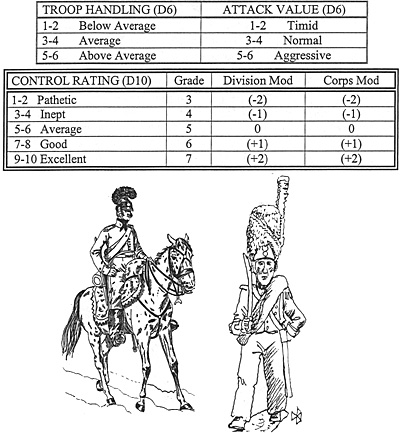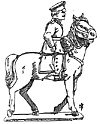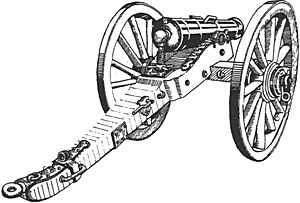 The following system has been developed around the Napoleonic period, but the system can be doctored to almost any other period. The central point of the system is totally random movement. There is no such thing as a moving sequence. Instead, there is a numbered card for every unit participating and, at the start of the move, these cards are shuffled and dealt out, one to each unit, completely at random. They are left face down, and unknown, until each unit has a card. Then, they are all turned over, and your move sequence is laid out before you. There is a slight variation to this, which depends upon Command Control, and at this point, I will explain the Command Control rules before getting back to the magic cards.
The following system has been developed around the Napoleonic period, but the system can be doctored to almost any other period. The central point of the system is totally random movement. There is no such thing as a moving sequence. Instead, there is a numbered card for every unit participating and, at the start of the move, these cards are shuffled and dealt out, one to each unit, completely at random. They are left face down, and unknown, until each unit has a card. Then, they are all turned over, and your move sequence is laid out before you. There is a slight variation to this, which depends upon Command Control, and at this point, I will explain the Command Control rules before getting back to the magic cards.
As I fight corps sized battles, I have a Brigade-Division-Corps command structure, with each commander having three characteristics: Troop Handing, Control Rating, Attack Value. To create random characters, I use the following table:
'Grade' refers to the roll each Brigadier must attempt each move, requiring less than the number shown on a D8. For instance, take a hypothetical idiot, (I'll call him Erskine), and he will suffice as an example. Let us assume that Erskine's character has been rolled up as TH (Troop Handing): Average, AV (Attack Value) Timid, CR (Control Rating) Pathetic.
Thus, at the start of the move, Erskine must roll 2 or less on a D8 to control his people. His only constraint being that he must be within his control range, otherwise, each unit out of range is automatically out of control. This range is 150 mm, using a scale of one yard per one mm. The Divisional and Corps modifiers, in brackets, referred to the relevant rank in the chain, providing each is within 300 mm of the next in line. Thus, if Erskine's Divisional General, Picton, (CR: Good), is within 300 mm at the start of the move, then Erskine needs only roll 3 or less. If the roll is 2, then Erskine is in control, and only one card need be selected for the entire formation. Any Battalion more than 150 mm gets a separate card of its own. Of course, if say a 6 was rolled, then everybody gets their own card regardless.
 So, what happens now that all the cards have been allocated, and turned over? Whoever has card one simply does whatever it is that they want to do, be it move, fire, melee, or whatever. So, if that lancer unit nearby draws card 4, and the open infantry in line draws card 15, then the lancers will be upon them before they can change formation. This is one circumstance where a unit can 'jump the queue'. The lancers having charged the valiant, but exposed infantry, the latter suddenly jump the queue to card 5 if you like, and they now carry-out whatever actions you consider logical. In this case, they would take a morale check, and either run, stand and fire or attempt to form a hasty square; all depending on the result of this test. Assuming they decide to stand and chance their arms: then, a close range volley would be in order prior to any contact. The result of this conflict might well cause other units to also 'jump the queue'. For instance, if the infantry break, then they may well force reaction tests on other units nearby, who, if they should fail, THEIR morale test may also break. The moment a unit is obliged to move, fire or whatever, it moves up to the next spot on the card roster. Hopefully, this should mean that, any unit obliged to jump the queue, will do as a result of having to react to something else, rather than as an instigator. That's the idea anyway!
So, what happens now that all the cards have been allocated, and turned over? Whoever has card one simply does whatever it is that they want to do, be it move, fire, melee, or whatever. So, if that lancer unit nearby draws card 4, and the open infantry in line draws card 15, then the lancers will be upon them before they can change formation. This is one circumstance where a unit can 'jump the queue'. The lancers having charged the valiant, but exposed infantry, the latter suddenly jump the queue to card 5 if you like, and they now carry-out whatever actions you consider logical. In this case, they would take a morale check, and either run, stand and fire or attempt to form a hasty square; all depending on the result of this test. Assuming they decide to stand and chance their arms: then, a close range volley would be in order prior to any contact. The result of this conflict might well cause other units to also 'jump the queue'. For instance, if the infantry break, then they may well force reaction tests on other units nearby, who, if they should fail, THEIR morale test may also break. The moment a unit is obliged to move, fire or whatever, it moves up to the next spot on the card roster. Hopefully, this should mean that, any unit obliged to jump the queue, will do as a result of having to react to something else, rather than as an instigator. That's the idea anyway!
This system should, therefore, enable a complete move to pass in total spontaneity, with the Soloist never ever able to predict a certain course of events.
 The next characteristic, Troop Handling, is mainly concerned with helping to randomise movement and formation changing. The basic move distances, I use, are as following:
The next characteristic, Troop Handling, is mainly concerned with helping to randomise movement and formation changing. The basic move distances, I use, are as following:
Foot Artillery: 150mm (Walk only). Horse Artillery, 250mm walk, 300mm Trot. (The relevance of 'Trot' will be disclosed in due course).
Random movement is governed by the use of modified dice. For Infantry, and Foot Artillery, each time a unit moves roll a D8, modified as follows. The sides are altered to read: +1, +2, +3, 0, 0, -1, -2, -3. This is the number of centimetres added or subtracted from the move. Cavalry, and Horse Artillery, use a D12 amended thus: +5 to -5 variations. On top of this, a Below Average TH rating adds one to the nearest extreme, whilst an Above Average TH Rating moves one towards the norm of '0'. For instance, Erskine is leading four Infantry battalions in column towards the French. In this case, because his troop handing is Average, he will make no amendments to the D8 rolls, which should aid his manoeuvring, providing that they are all in line next to each other, and, he has managed to control them into moving as a formation.
 The Troop Handing rating has another effect; that being on formation changes. To cover this, when a unit wishes to change formation, I roll a D6 to determine the number of quarters of movement taken up, (4 quarters per move), using the following modifiers:
The Troop Handing rating has another effect; that being on formation changes. To cover this, when a unit wishes to change formation, I roll a D6 to determine the number of quarters of movement taken up, (4 quarters per move), using the following modifiers:
- Militia +1
Elite -1
Guards -2
Brigadier's TH below average +1
Out of Control +2
Brigadier's TH above average -1
Thus, some troops will carry on, partially changed, into the next move, whilst others can do within one move with luck.
The attack Value of a general, affects both the morale system, and the chances of stopping and starting his troops. When I want to get a unit moving from a standstill, I again roll the obligatory D6, when a result of '1' means "No thank you, I have something better to do". The Aggressive leader's roll with a +1 modifier, and the Timid with a minus 1. The reverse is true for halting. A '6' being required for the troops to ignore you and carry-on regardless. As you can see, a Timid leader is easy to stop, but harder to start. As for the Aggressive, I always, think of Ney at Waterloo, you unleash him, and hope.
To simulate all the disorder that I suddenly became faced with, I use 'D' (for disorder) markers. Units pick up D's for a wide variety of reasons, but, like practically everything else in this article, what those are, is a matter of personal taste.
The ones I use are as follows:
- Cavalry Trot move 1 D per turn
Horse Artillery Trot 1 D per turn
Each round of combat 1 D
Each move routing 2 D
Each move of pursuit 1 D
Each move of retreat 1 D
Still changing formation at the end of a move 1 D
To remove 'D' factors, I require the unit to have been static, doing nothing else whatever, and not to have been under fire. Then I resort to the usual D6 for the number of factors removed. Modifiers of
- +1 for Elite Guards or Veterans
-1 for Militia.
That's about how my solo Napoleonics go. As you can see, the emphasis is on NOT being able to predict events.
Back to Table of Contents -- Lone Warrior # 145
Back to Lone Warrior List of Issues
Back to MagWeb Magazine List
© Copyright 2004 by Solo Wargamers Association.
This article appears in MagWeb (Magazine Web) on the Internet World Wide Web.
Other articles from military history and related magazines are available at http://www.magweb.com
